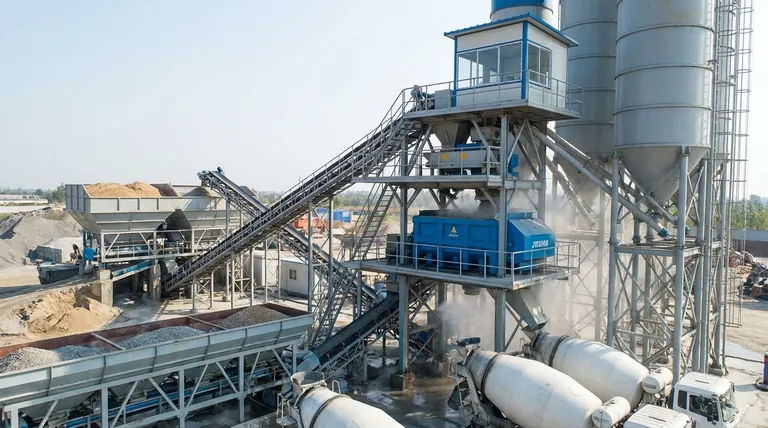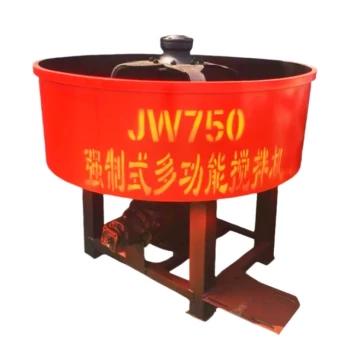At its core, the process of concrete plant mixing is a highly automated industrial operation designed to combine raw materials in exact proportions to produce a uniform mixture with specific, predictable properties. It transforms basic components—aggregates, sand, cement, and water—into engineered concrete through a sequence of storage, conveying, weighing, and mixing, all governed by a central control system.
The key to understanding concrete plant mixing is to see it not as simple mixing, but as a precise manufacturing process. The entire operation is built around five interconnected systems working together to ensure every batch meets exact engineering specifications for consistency and strength.

The Core Systems of a Concrete Mixing Plant
A large concrete mixing plant's operation can be broken down into five primary systems that work in sequence. Each system plays a critical role in the final quality of the concrete.
Material Storage System
This is the starting point of the entire process. Raw materials are stored in separate, designated containers to prevent contamination and ensure a ready supply.
Aggregates (gravel, crushed stone) and sand are typically kept in large bins or hoppers. Cement and other supplementary powders are stored in tall, weather-proof silos to protect them from moisture.
Material Conveying System
Once a batch is ordered, the conveying system moves the raw materials from storage to the weighing system. This is a crucial link in the automation chain.
Belt conveyors are commonly used to transport aggregates and sand from the bins. Screw conveyors (augers) are used to move cement and powders from the silos, allowing for more controlled and enclosed transport.
Material Weighing System
This is arguably the most critical system for ensuring concrete quality. Precision here is paramount, as the final properties of the concrete depend entirely on the correct proportions of each ingredient.
Using highly accurate load cells and sensors, each material—aggregate, sand, cement, water, and any admixtures—is weighed individually according to the specific mix design programmed into the control system.
The Mixing Host (The Mixer)
After being weighed, all the materials are discharged into the main mixing unit, often called the mixing host. This is where the physical blending occurs to create a homogenous product.
The mixer, which can be a rotating drum or a more complex twin-shaft design, agitates the components vigorously. The goal is to ensure every particle of sand and aggregate is coated with cement paste (cement and water), resulting in a consistent, workable mix.
The Control System
The control system is the brain of the entire operation. It is typically managed by a Programmable Logic Controller (PLC) that oversees every step of the process.
From initiating the conveying of materials to verifying the weights and controlling the mixing time, the control system automates the entire batching sequence. It also manages auxiliary functions, such as the automatic lubrication of mechanical parts, to ensure plant reliability.
Understanding the Trade-offs and Quality Factors
While the process is automated, the quality of the final product is not guaranteed. Several factors can impact the consistency and performance of the concrete produced.
Component Quality is Non-Negotiable
The reliability of the plant is directly tied to the quality of its components. Inaccurate sensors in the weighing system can lead to incorrect mix proportions, compromising the concrete's strength.
Failures in belts, motors, or seals can cause costly downtime. This is why high-quality plants use components from reputable brands, as this directly translates to a more reliable and consistent end product.
Wet Mix vs. Dry Mix Plants
The process described above is for a "wet mix" plant, where all ingredients, including water, are mixed at the plant before being loaded into a transit mixer truck. This ensures the highest level of quality control and consistency.
An alternative is a "dry mix" plant, where the dry ingredients are weighed and loaded into the truck, with water being added and mixed en route to the job site. While potentially faster, this method introduces variables that can compromise the final quality if not managed perfectly.
The Critical Role of Calibration
An automated system is only as good as its last calibration. The weighing systems must be regularly calibrated and maintained to ensure their accuracy. Without proper calibration, even the most advanced control system will produce faulty batches based on incorrect data.
Matching the Process to Your Project Needs
Your project's requirements will determine what to look for in a concrete supply.
- If your primary focus is maximum quality and structural integrity: Specify concrete from a certified "wet mix" plant with a fully automated PLC control system.
- If your primary focus is large volume for non-structural applications: A "dry mix" plant may be sufficient, but you must implement rigorous on-site quality control for water addition.
- If you are selecting a plant for purchase: Prioritize the accuracy of the weighing system and the sophistication of the control system, as these have the greatest impact on product quality and operational efficiency.
Understanding this automated process is the key to specifying and receiving concrete that meets precise engineering standards.
Summary Table:
| System | Key Function | Impact on Final Concrete |
|---|---|---|
| Material Storage | Holds aggregates, sand, cement in separate bins/silos | Prevents contamination, ensures material readiness |
| Material Conveying | Transports materials (belts for aggregate, augers for cement) | Enables automation and controlled feeding |
| Material Weighing | Precisely measures each ingredient via load cells | Most critical for strength and consistency |
| Mixing Host | Blends materials into a homogenous mixture (drum or twin-shaft) | Ensures uniform coating of aggregates with cement paste |
| Control System (PLC) | Automates the entire batching sequence | Guarantees repeatable quality and operational efficiency |
Need a Reliable Concrete Batching Plant for Your Project?
Understanding the process is the first step. The next is ensuring you have equipment that executes it flawlessly. GARLWAY specializes in manufacturing high-performance construction machinery, including durable and precise concrete batching plants, concrete mixers, and winches.
We help construction companies and contractors globally achieve consistent, high-quality concrete production, batch after batch. Our plants feature accurate weighing systems and sophisticated PLC controls to match your project's demands for quality and volume.
Let's discuss your specific requirements and how we can support your operations. Contact our experts today for a customized solution!
Visual Guide

Related Products
- Ready Mixer Machine for Construction Ready Mix Machinery
- Portable Concrete Mixer Machine Equipment for Mixing Concrete
- Commercial Construction Mixer Machine for Soil Cement Mixing Concrete
- JW1000 Mobile Cement Mixer Concrete Mixer Truck and Batching Plant
- Portable Electric Concrete Mixer Machine for Cement Mixing
People Also Ask
- What is the average lifespan of a concrete mixer? Maximize Your Equipment's Lifespan & ROI
- When was the first concrete mixer developed and by whom? Discover the 1900 Breakthrough
- Why is the manufacturer's strength and service important when choosing a concrete mixer? Ensure Long-Term Project Success
- Which type of projects require a concrete mixer? Essential Guide for Construction Pros
- What should be considered regarding the output of a concrete mixer? Match Capacity to Your Project Scale


















